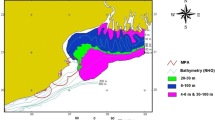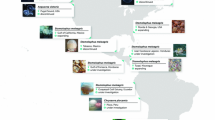Abstract
Jellyfish cause a range of problems: they sting beach vacationers in the summer, block nuclear power plant intakes (thus disrupting the supply of electricity), decrease fishery catches, cause fishing activities to be delayed, decrease product value, and damage fishing gear. This study gauged the types and amount of damage directly caused by jellyfish. Using jellyfish monitoring data, the decreases in catch and product value for each fishery type as well as the estimated damage to each fishery type caused by jellyfish were evaluated. The results showed that the decrease in catch ranged between 6.5 and 33.7 %, and the decrease in product value ranged between 6.8 and 25.3 %, depending on fishery type. The annual direct damage caused by jellyfish was estimated to be between US$ 68.2 million and US$ 204.6 million. This corresponds to a minimum of 2.1 % and a maximum of 25 % of the annual production value, demonstrating that jellyfish cause considerable damage to the fishing industry.
Similar content being viewed by others
References
Arai M (1997) A functional biology of scyphozoa. Chapman & Hall, London
Purcell J, Arai M (2001) Interactions of pelagic cnidarians and ctenophores with fish: a review. Hydrobiologia 451:27–44
Purcell J (2005) Climate effects on formation of jellyfish and ctenophore blooms: a review. J Mar Bio Assoc UK 85:461–476
Purcell J, Uye S, Lo W (2007) Anthropogenic causes of jellyfish blooms and their direct consequences for human: a review. Mar Eco Pro Ser 350:153–175
Jankowski T, Strauss T, Ratte H (2005) Trophic interactions of the freshwater jellyfish Craspedacusta sowerbii. J Plank Res 27:811–823
Lynam C, Heath M, Hay S, Brierley A (2005) Evidence for impacts by jellyfish on North Sea herring recruitment. Mar Eco Pro Ser 298:157–167
Uye S, Shimauchi H (2005) Population biomass, feeding, respiration and growth rates, and carbon budget of the scyphomedusa Aurelia aurita in the Inland Sea of Japan. J Plank Res 27:237–248
Verity P, Smetacek V (1996) Organism life cycle, predation, and the structure of marine pelagic ecosystems. Mar Eco Pro Ser 130:277–293
Arai M (2001) Pelagic coelenterates and eutrophication: a review. Hydrobiologia 451:69–87
Parsons T, Lalli C (2002) Jellyfish population explosions: revisiting a hypothesis of possible causes. La Mer 40:111–121
Yasuda T (2004) Massive blooms of the giant medusa in Japanese waters from late summer to winter in 2002. Bull Plank Soc Jpn 51:34–37
Fenner PJ (1997) The global problem of cnidarian (jellyfish) stinging (MD thesis). University of London, London
Graham W, Martin D, Felder D, Asper V, Perry H (2003) Ecology and economic implications of a tropical jellyfish invader in the Gulf of Mexico. Bio Inv 5:53–69
Yasuda T (1988) Unusually gregarious occurrences of jellyfishes in Japanese waters. Saishu to Shiiku 50:338–346
Yoon W (2008) Mass occurrence of jellyfish and prevention and utilization. National Fisheries Research and Development Institute, Busan, Korea
Acknowledgments
Thanks to Dr. Mi-Hee Chung and personnel at the Jellyfish Monitoring Information Center at the National Fisheries Research and Development Institute for their assistance with obtaining the necessary information.
Author information
Authors and Affiliations
Corresponding author
Rights and permissions
About this article
Cite this article
Kim, DH., Seo, JN., Yoon, WD. et al. Estimating the economic damage caused by jellyfish to fisheries in Korea. Fish Sci 78, 1147–1152 (2012). https://doi.org/10.1007/s12562-012-0533-1
Received:
Accepted:
Published:
Issue Date:
DOI: https://doi.org/10.1007/s12562-012-0533-1




